Personal Profile of Skill Acquisition Assesment
VerifiedAdded on 2022/08/25
|13
|3960
|22
AI Summary
Contribute Materials
Your contribution can guide someone’s learning journey. Share your
documents today.
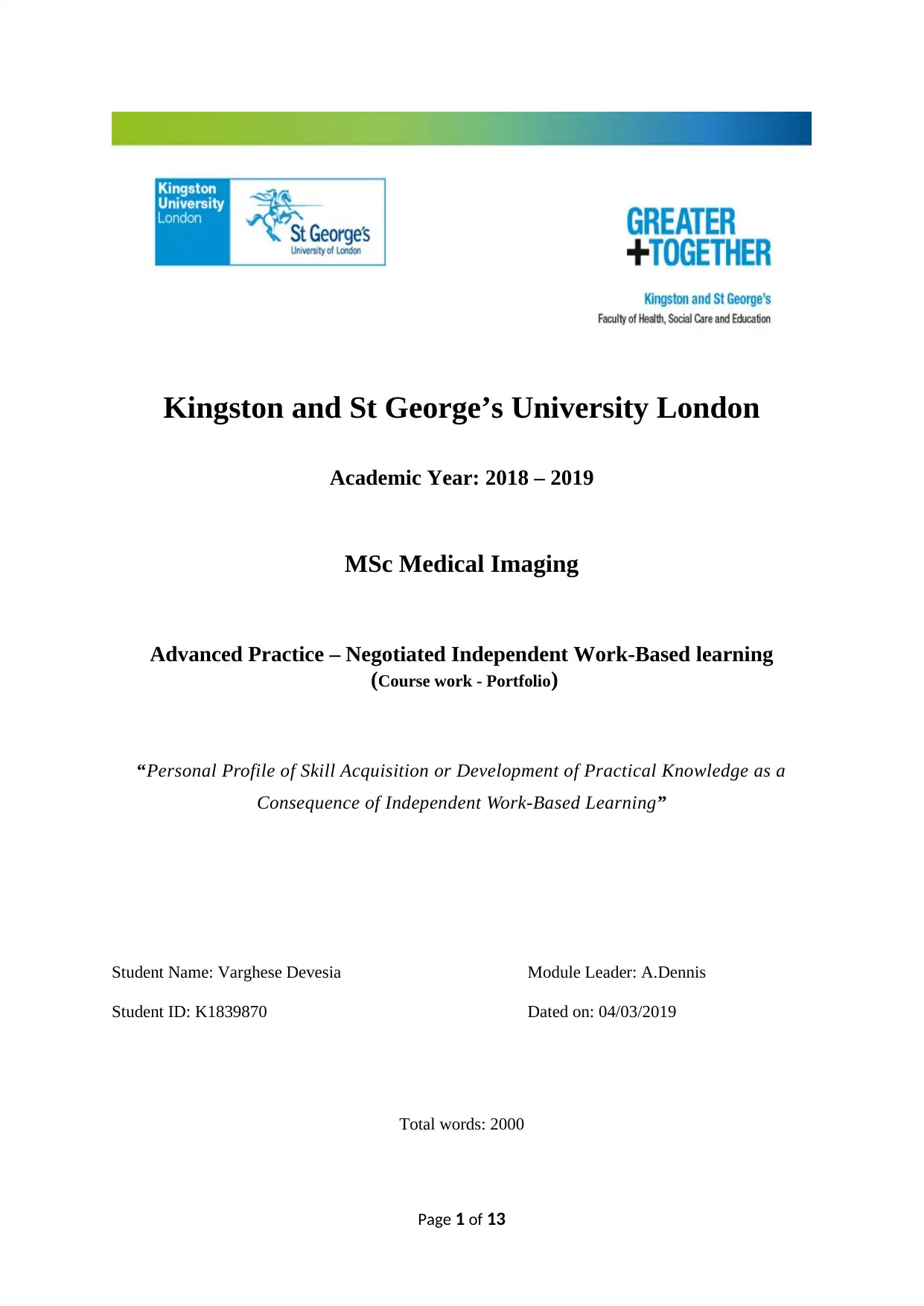
Kingston and St George’s University London
Academic Year: 2018 – 2019
MSc Medical Imaging
Advanced Practice – Negotiated Independent Work-Based learning
(Course work - Portfolio)
“Personal Profile of Skill Acquisition or Development of Practical Knowledge as a
Consequence of Independent Work-Based Learning”
Student Name: Varghese Devesia Module Leader: A.Dennis
Student ID: K1839870 Dated on: 04/03/2019
Total words: 2000
Page 1 of 13
Academic Year: 2018 – 2019
MSc Medical Imaging
Advanced Practice – Negotiated Independent Work-Based learning
(Course work - Portfolio)
“Personal Profile of Skill Acquisition or Development of Practical Knowledge as a
Consequence of Independent Work-Based Learning”
Student Name: Varghese Devesia Module Leader: A.Dennis
Student ID: K1839870 Dated on: 04/03/2019
Total words: 2000
Page 1 of 13
Secure Best Marks with AI Grader
Need help grading? Try our AI Grader for instant feedback on your assignments.
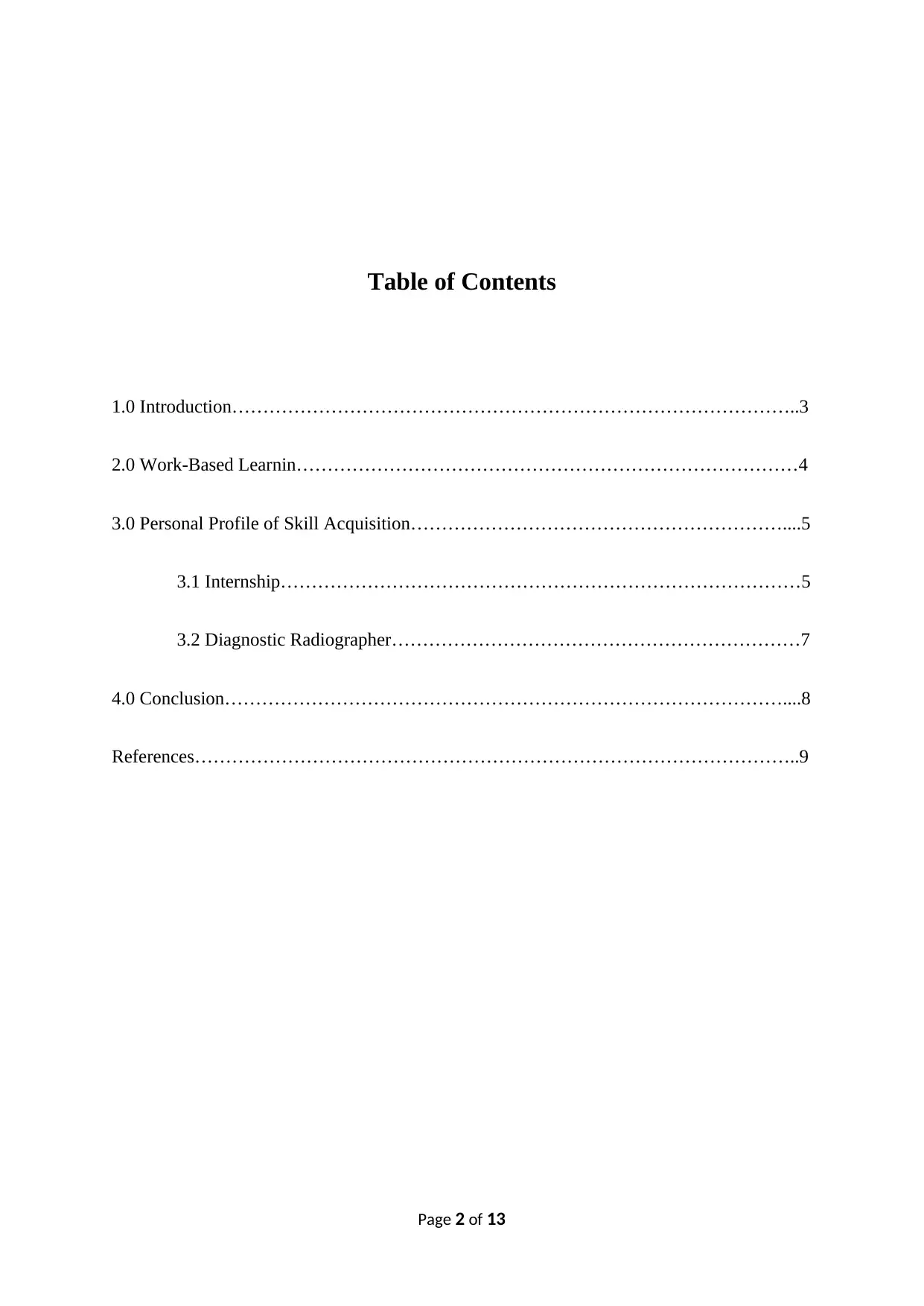
Table of Contents
1.0 Introduction………………………………………………………………………………..3
2.0 Work-Based Learnin………………………………………………………………………4
3.0 Personal Profile of Skill Acquisition……………………………………………………....5
3.1 Internship…………………………………………………………………………5
3.2 Diagnostic Radiographer…………………………………………………………7
4.0 Conclusion………………………………………………………………………………....8
References……………………………………………………………………………………..9
Page 2 of 13
1.0 Introduction………………………………………………………………………………..3
2.0 Work-Based Learnin………………………………………………………………………4
3.0 Personal Profile of Skill Acquisition……………………………………………………....5
3.1 Internship…………………………………………………………………………5
3.2 Diagnostic Radiographer…………………………………………………………7
4.0 Conclusion………………………………………………………………………………....8
References……………………………………………………………………………………..9
Page 2 of 13
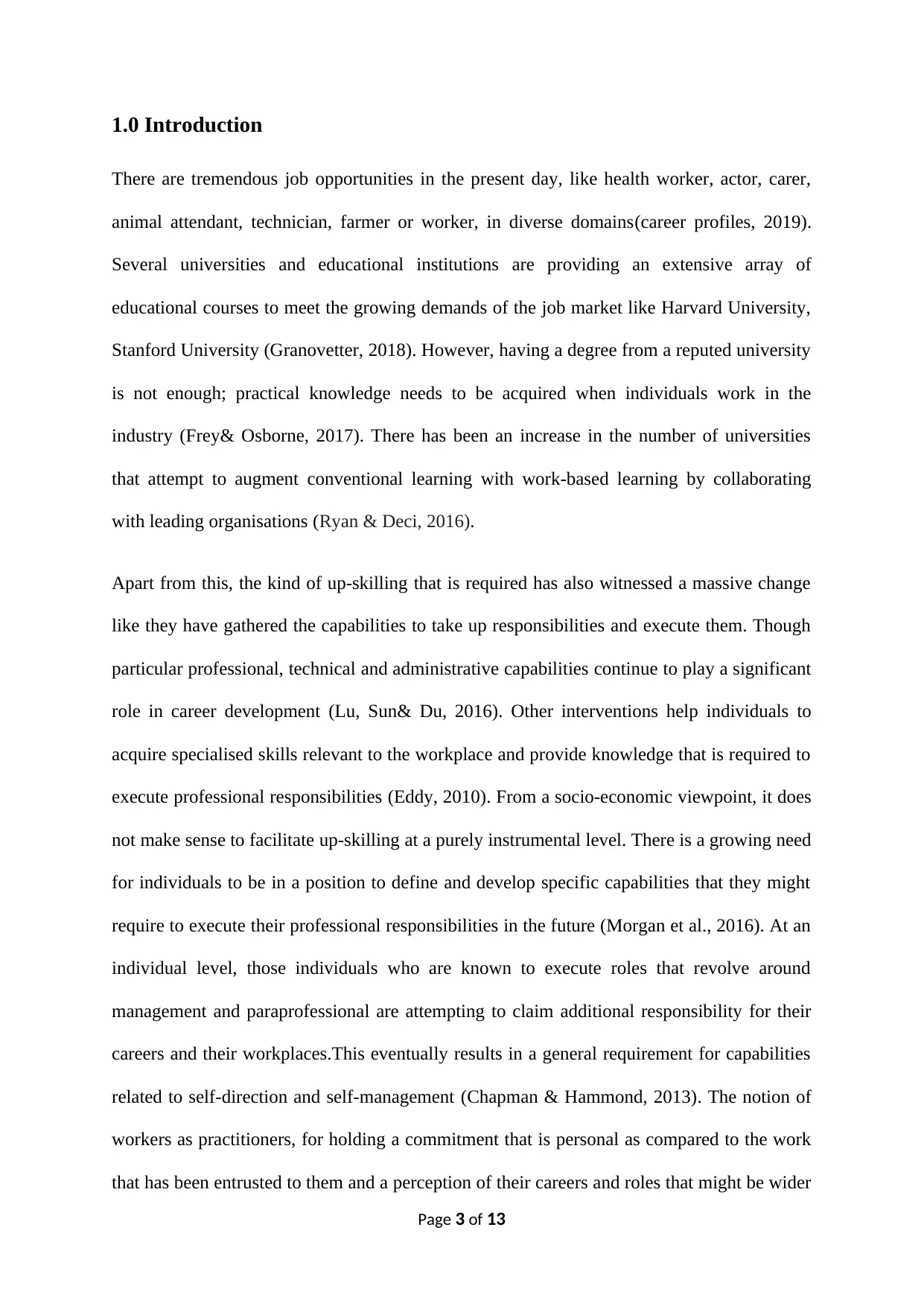
1.0 Introduction
There are tremendous job opportunities in the present day, like health worker, actor, carer,
animal attendant, technician, farmer or worker, in diverse domains(career profiles, 2019).
Several universities and educational institutions are providing an extensive array of
educational courses to meet the growing demands of the job market like Harvard University,
Stanford University (Granovetter, 2018). However, having a degree from a reputed university
is not enough; practical knowledge needs to be acquired when individuals work in the
industry (Frey& Osborne, 2017). There has been an increase in the number of universities
that attempt to augment conventional learning with work-based learning by collaborating
with leading organisations (Ryan & Deci, 2016).
Apart from this, the kind of up-skilling that is required has also witnessed a massive change
like they have gathered the capabilities to take up responsibilities and execute them. Though
particular professional, technical and administrative capabilities continue to play a significant
role in career development (Lu, Sun& Du, 2016). Other interventions help individuals to
acquire specialised skills relevant to the workplace and provide knowledge that is required to
execute professional responsibilities (Eddy, 2010). From a socio-economic viewpoint, it does
not make sense to facilitate up-skilling at a purely instrumental level. There is a growing need
for individuals to be in a position to define and develop specific capabilities that they might
require to execute their professional responsibilities in the future (Morgan et al., 2016). At an
individual level, those individuals who are known to execute roles that revolve around
management and paraprofessional are attempting to claim additional responsibility for their
careers and their workplaces.This eventually results in a general requirement for capabilities
related to self-direction and self-management (Chapman & Hammond, 2013). The notion of
workers as practitioners, for holding a commitment that is personal as compared to the work
that has been entrusted to them and a perception of their careers and roles that might be wider
Page 3 of 13
There are tremendous job opportunities in the present day, like health worker, actor, carer,
animal attendant, technician, farmer or worker, in diverse domains(career profiles, 2019).
Several universities and educational institutions are providing an extensive array of
educational courses to meet the growing demands of the job market like Harvard University,
Stanford University (Granovetter, 2018). However, having a degree from a reputed university
is not enough; practical knowledge needs to be acquired when individuals work in the
industry (Frey& Osborne, 2017). There has been an increase in the number of universities
that attempt to augment conventional learning with work-based learning by collaborating
with leading organisations (Ryan & Deci, 2016).
Apart from this, the kind of up-skilling that is required has also witnessed a massive change
like they have gathered the capabilities to take up responsibilities and execute them. Though
particular professional, technical and administrative capabilities continue to play a significant
role in career development (Lu, Sun& Du, 2016). Other interventions help individuals to
acquire specialised skills relevant to the workplace and provide knowledge that is required to
execute professional responsibilities (Eddy, 2010). From a socio-economic viewpoint, it does
not make sense to facilitate up-skilling at a purely instrumental level. There is a growing need
for individuals to be in a position to define and develop specific capabilities that they might
require to execute their professional responsibilities in the future (Morgan et al., 2016). At an
individual level, those individuals who are known to execute roles that revolve around
management and paraprofessional are attempting to claim additional responsibility for their
careers and their workplaces.This eventually results in a general requirement for capabilities
related to self-direction and self-management (Chapman & Hammond, 2013). The notion of
workers as practitioners, for holding a commitment that is personal as compared to the work
that has been entrusted to them and a perception of their careers and roles that might be wider
Page 3 of 13
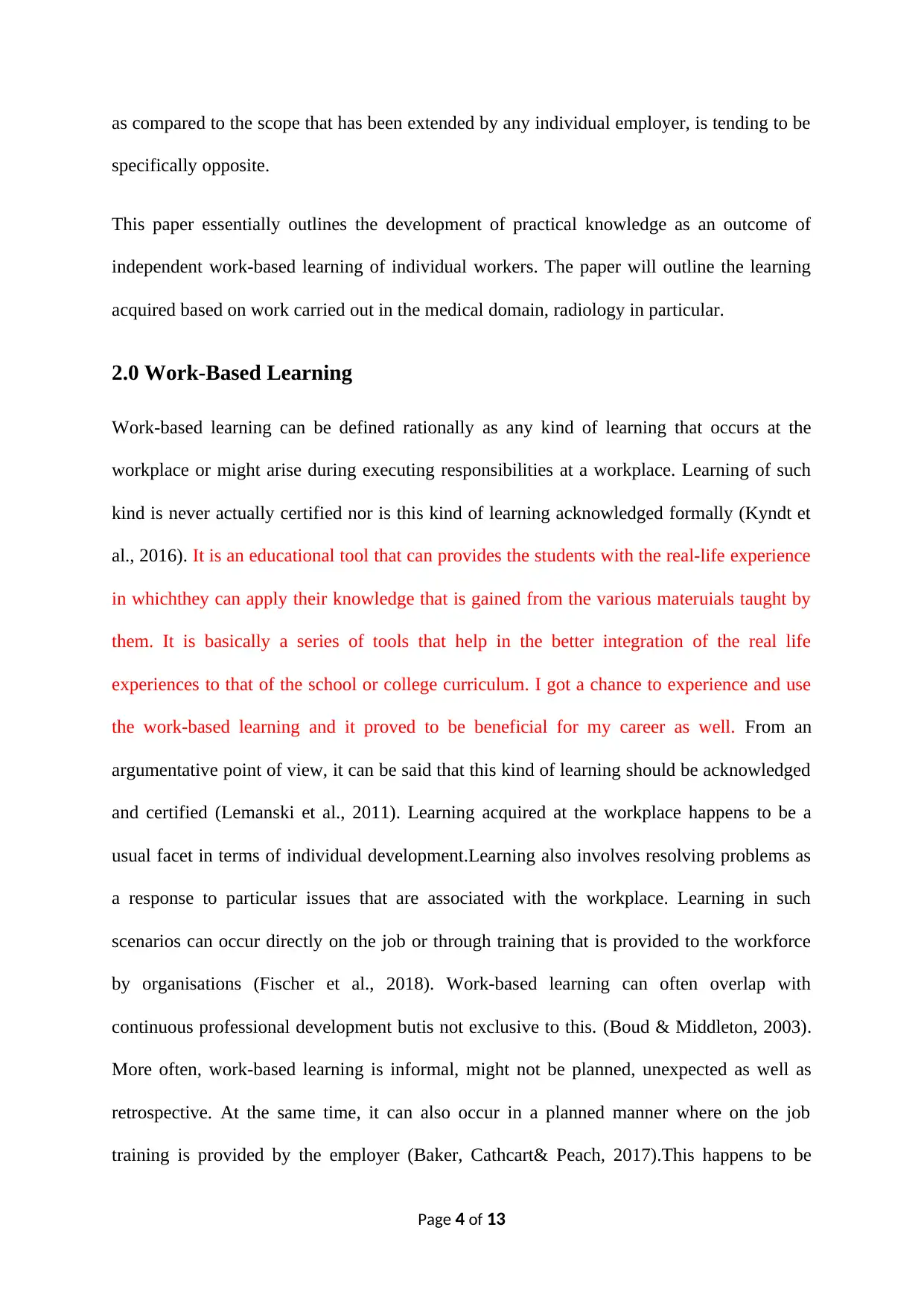
as compared to the scope that has been extended by any individual employer, is tending to be
specifically opposite.
This paper essentially outlines the development of practical knowledge as an outcome of
independent work-based learning of individual workers. The paper will outline the learning
acquired based on work carried out in the medical domain, radiology in particular.
2.0 Work-Based Learning
Work-based learning can be defined rationally as any kind of learning that occurs at the
workplace or might arise during executing responsibilities at a workplace. Learning of such
kind is never actually certified nor is this kind of learning acknowledged formally (Kyndt et
al., 2016). It is an educational tool that can provides the students with the real-life experience
in whichthey can apply their knowledge that is gained from the various materuials taught by
them. It is basically a series of tools that help in the better integration of the real life
experiences to that of the school or college curriculum. I got a chance to experience and use
the work-based learning and it proved to be beneficial for my career as well. From an
argumentative point of view, it can be said that this kind of learning should be acknowledged
and certified (Lemanski et al., 2011). Learning acquired at the workplace happens to be a
usual facet in terms of individual development.Learning also involves resolving problems as
a response to particular issues that are associated with the workplace. Learning in such
scenarios can occur directly on the job or through training that is provided to the workforce
by organisations (Fischer et al., 2018). Work-based learning can often overlap with
continuous professional development butis not exclusive to this. (Boud & Middleton, 2003).
More often, work-based learning is informal, might not be planned, unexpected as well as
retrospective. At the same time, it can also occur in a planned manner where on the job
training is provided by the employer (Baker, Cathcart& Peach, 2017).This happens to be
Page 4 of 13
specifically opposite.
This paper essentially outlines the development of practical knowledge as an outcome of
independent work-based learning of individual workers. The paper will outline the learning
acquired based on work carried out in the medical domain, radiology in particular.
2.0 Work-Based Learning
Work-based learning can be defined rationally as any kind of learning that occurs at the
workplace or might arise during executing responsibilities at a workplace. Learning of such
kind is never actually certified nor is this kind of learning acknowledged formally (Kyndt et
al., 2016). It is an educational tool that can provides the students with the real-life experience
in whichthey can apply their knowledge that is gained from the various materuials taught by
them. It is basically a series of tools that help in the better integration of the real life
experiences to that of the school or college curriculum. I got a chance to experience and use
the work-based learning and it proved to be beneficial for my career as well. From an
argumentative point of view, it can be said that this kind of learning should be acknowledged
and certified (Lemanski et al., 2011). Learning acquired at the workplace happens to be a
usual facet in terms of individual development.Learning also involves resolving problems as
a response to particular issues that are associated with the workplace. Learning in such
scenarios can occur directly on the job or through training that is provided to the workforce
by organisations (Fischer et al., 2018). Work-based learning can often overlap with
continuous professional development butis not exclusive to this. (Boud & Middleton, 2003).
More often, work-based learning is informal, might not be planned, unexpected as well as
retrospective. At the same time, it can also occur in a planned manner where on the job
training is provided by the employer (Baker, Cathcart& Peach, 2017).This happens to be
Page 4 of 13
Secure Best Marks with AI Grader
Need help grading? Try our AI Grader for instant feedback on your assignments.
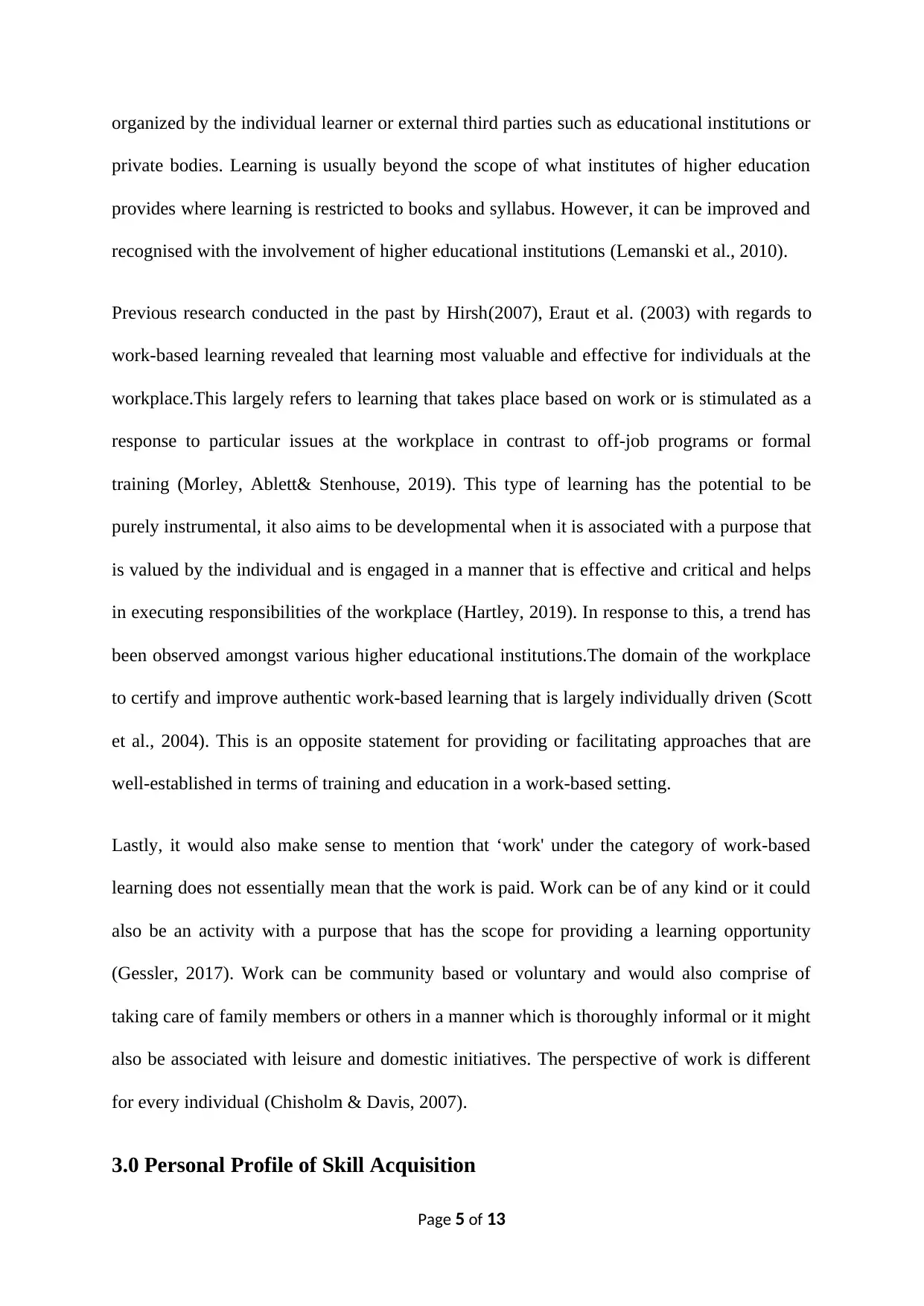
organized by the individual learner or external third parties such as educational institutions or
private bodies. Learning is usually beyond the scope of what institutes of higher education
provides where learning is restricted to books and syllabus. However, it can be improved and
recognised with the involvement of higher educational institutions (Lemanski et al., 2010).
Previous research conducted in the past by Hirsh(2007), Eraut et al. (2003) with regards to
work-based learning revealed that learning most valuable and effective for individuals at the
workplace.This largely refers to learning that takes place based on work or is stimulated as a
response to particular issues at the workplace in contrast to off-job programs or formal
training (Morley, Ablett& Stenhouse, 2019). This type of learning has the potential to be
purely instrumental, it also aims to be developmental when it is associated with a purpose that
is valued by the individual and is engaged in a manner that is effective and critical and helps
in executing responsibilities of the workplace (Hartley, 2019). In response to this, a trend has
been observed amongst various higher educational institutions.The domain of the workplace
to certify and improve authentic work-based learning that is largely individually driven (Scott
et al., 2004). This is an opposite statement for providing or facilitating approaches that are
well-established in terms of training and education in a work-based setting.
Lastly, it would also make sense to mention that ‘work' under the category of work-based
learning does not essentially mean that the work is paid. Work can be of any kind or it could
also be an activity with a purpose that has the scope for providing a learning opportunity
(Gessler, 2017). Work can be community based or voluntary and would also comprise of
taking care of family members or others in a manner which is thoroughly informal or it might
also be associated with leisure and domestic initiatives. The perspective of work is different
for every individual (Chisholm & Davis, 2007).
3.0 Personal Profile of Skill Acquisition
Page 5 of 13
private bodies. Learning is usually beyond the scope of what institutes of higher education
provides where learning is restricted to books and syllabus. However, it can be improved and
recognised with the involvement of higher educational institutions (Lemanski et al., 2010).
Previous research conducted in the past by Hirsh(2007), Eraut et al. (2003) with regards to
work-based learning revealed that learning most valuable and effective for individuals at the
workplace.This largely refers to learning that takes place based on work or is stimulated as a
response to particular issues at the workplace in contrast to off-job programs or formal
training (Morley, Ablett& Stenhouse, 2019). This type of learning has the potential to be
purely instrumental, it also aims to be developmental when it is associated with a purpose that
is valued by the individual and is engaged in a manner that is effective and critical and helps
in executing responsibilities of the workplace (Hartley, 2019). In response to this, a trend has
been observed amongst various higher educational institutions.The domain of the workplace
to certify and improve authentic work-based learning that is largely individually driven (Scott
et al., 2004). This is an opposite statement for providing or facilitating approaches that are
well-established in terms of training and education in a work-based setting.
Lastly, it would also make sense to mention that ‘work' under the category of work-based
learning does not essentially mean that the work is paid. Work can be of any kind or it could
also be an activity with a purpose that has the scope for providing a learning opportunity
(Gessler, 2017). Work can be community based or voluntary and would also comprise of
taking care of family members or others in a manner which is thoroughly informal or it might
also be associated with leisure and domestic initiatives. The perspective of work is different
for every individual (Chisholm & Davis, 2007).
3.0 Personal Profile of Skill Acquisition
Page 5 of 13
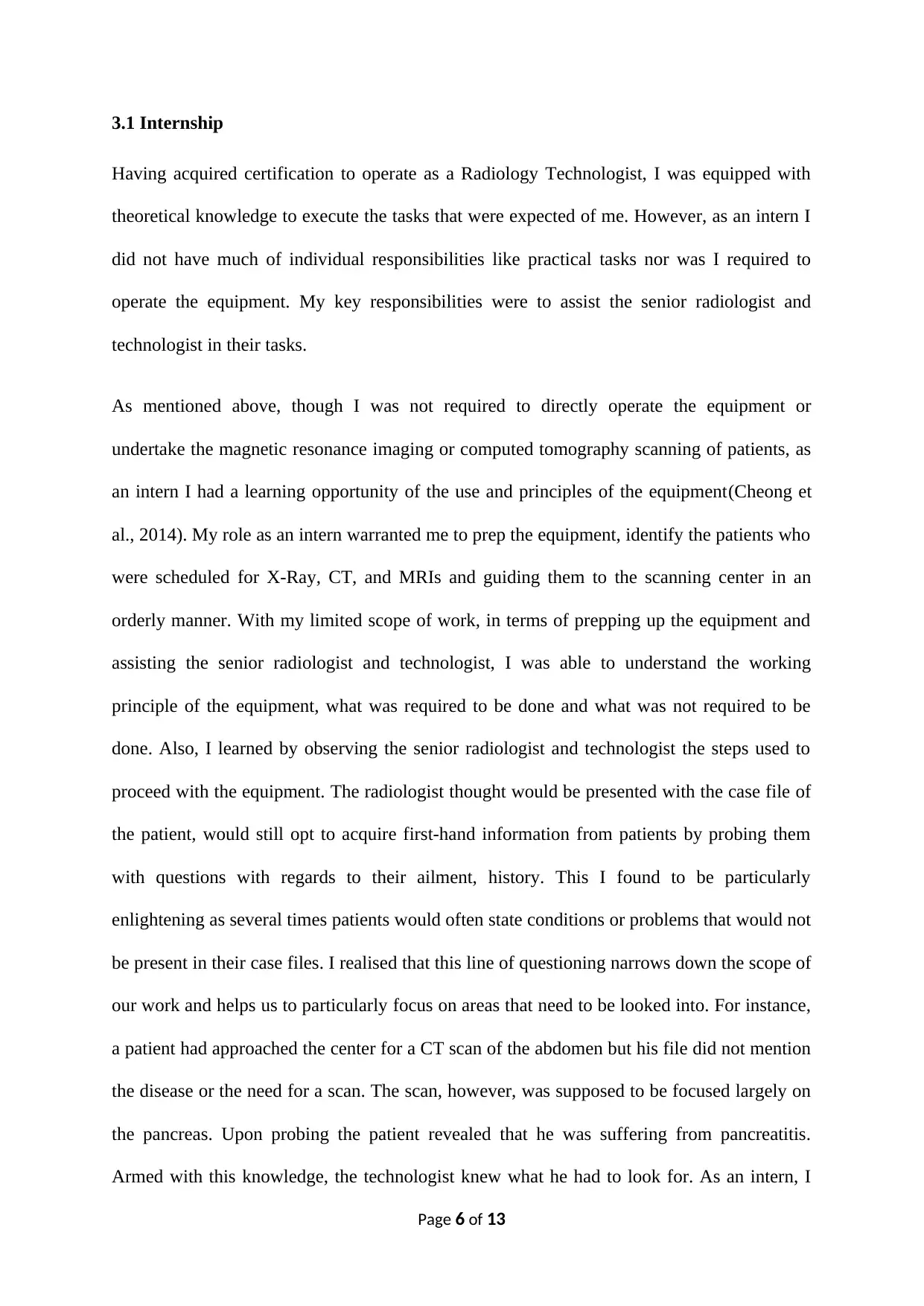
3.1 Internship
Having acquired certification to operate as a Radiology Technologist, I was equipped with
theoretical knowledge to execute the tasks that were expected of me. However, as an intern I
did not have much of individual responsibilities like practical tasks nor was I required to
operate the equipment. My key responsibilities were to assist the senior radiologist and
technologist in their tasks.
As mentioned above, though I was not required to directly operate the equipment or
undertake the magnetic resonance imaging or computed tomography scanning of patients, as
an intern I had a learning opportunity of the use and principles of the equipment(Cheong et
al., 2014). My role as an intern warranted me to prep the equipment, identify the patients who
were scheduled for X-Ray, CT, and MRIs and guiding them to the scanning center in an
orderly manner. With my limited scope of work, in terms of prepping up the equipment and
assisting the senior radiologist and technologist, I was able to understand the working
principle of the equipment, what was required to be done and what was not required to be
done. Also, I learned by observing the senior radiologist and technologist the steps used to
proceed with the equipment. The radiologist thought would be presented with the case file of
the patient, would still opt to acquire first-hand information from patients by probing them
with questions with regards to their ailment, history. This I found to be particularly
enlightening as several times patients would often state conditions or problems that would not
be present in their case files. I realised that this line of questioning narrows down the scope of
our work and helps us to particularly focus on areas that need to be looked into. For instance,
a patient had approached the center for a CT scan of the abdomen but his file did not mention
the disease or the need for a scan. The scan, however, was supposed to be focused largely on
the pancreas. Upon probing the patient revealed that he was suffering from pancreatitis.
Armed with this knowledge, the technologist knew what he had to look for. As an intern, I
Page 6 of 13
Having acquired certification to operate as a Radiology Technologist, I was equipped with
theoretical knowledge to execute the tasks that were expected of me. However, as an intern I
did not have much of individual responsibilities like practical tasks nor was I required to
operate the equipment. My key responsibilities were to assist the senior radiologist and
technologist in their tasks.
As mentioned above, though I was not required to directly operate the equipment or
undertake the magnetic resonance imaging or computed tomography scanning of patients, as
an intern I had a learning opportunity of the use and principles of the equipment(Cheong et
al., 2014). My role as an intern warranted me to prep the equipment, identify the patients who
were scheduled for X-Ray, CT, and MRIs and guiding them to the scanning center in an
orderly manner. With my limited scope of work, in terms of prepping up the equipment and
assisting the senior radiologist and technologist, I was able to understand the working
principle of the equipment, what was required to be done and what was not required to be
done. Also, I learned by observing the senior radiologist and technologist the steps used to
proceed with the equipment. The radiologist thought would be presented with the case file of
the patient, would still opt to acquire first-hand information from patients by probing them
with questions with regards to their ailment, history. This I found to be particularly
enlightening as several times patients would often state conditions or problems that would not
be present in their case files. I realised that this line of questioning narrows down the scope of
our work and helps us to particularly focus on areas that need to be looked into. For instance,
a patient had approached the center for a CT scan of the abdomen but his file did not mention
the disease or the need for a scan. The scan, however, was supposed to be focused largely on
the pancreas. Upon probing the patient revealed that he was suffering from pancreatitis.
Armed with this knowledge, the technologist knew what he had to look for. As an intern, I
Page 6 of 13
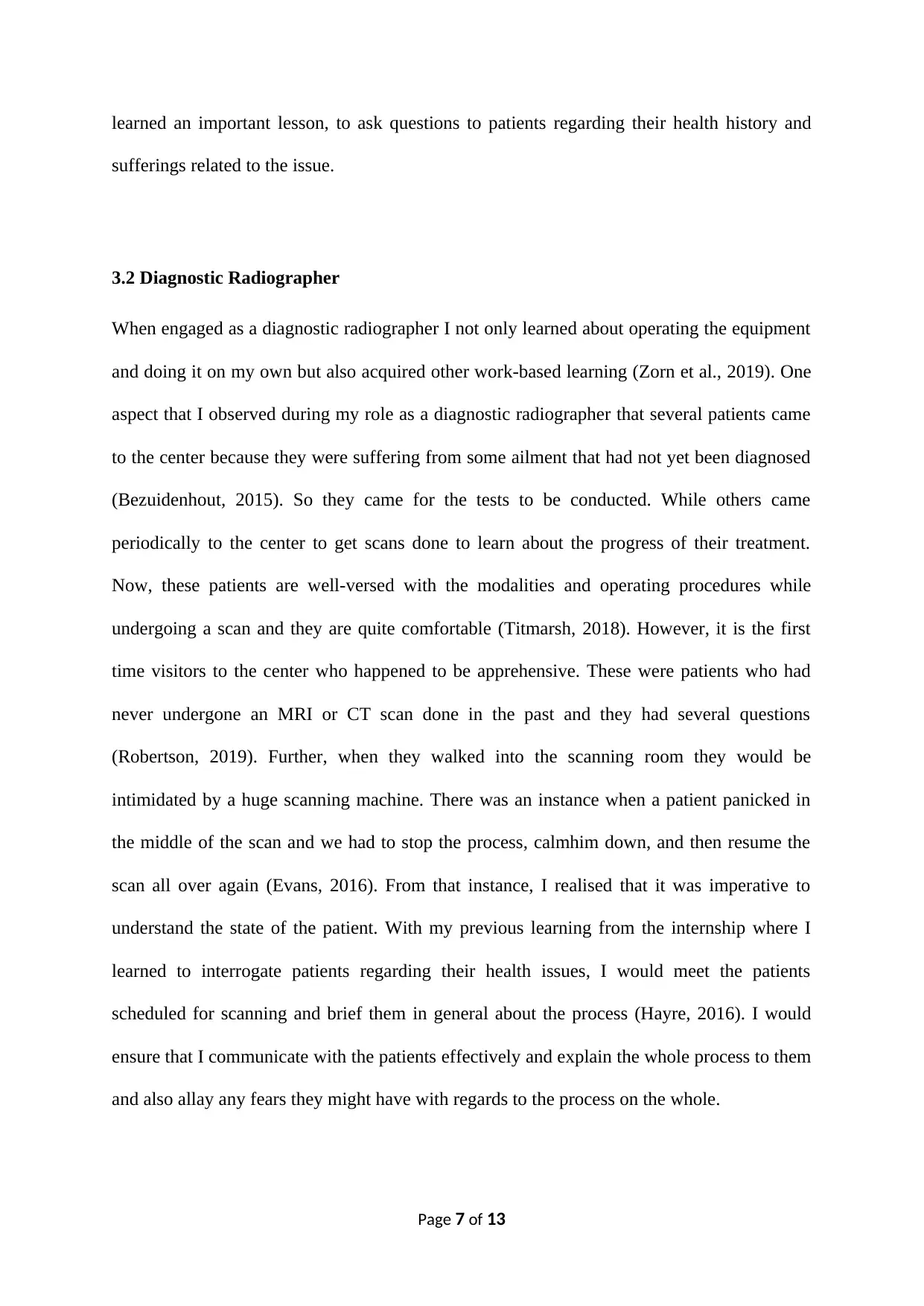
learned an important lesson, to ask questions to patients regarding their health history and
sufferings related to the issue.
3.2 Diagnostic Radiographer
When engaged as a diagnostic radiographer I not only learned about operating the equipment
and doing it on my own but also acquired other work-based learning (Zorn et al., 2019). One
aspect that I observed during my role as a diagnostic radiographer that several patients came
to the center because they were suffering from some ailment that had not yet been diagnosed
(Bezuidenhout, 2015). So they came for the tests to be conducted. While others came
periodically to the center to get scans done to learn about the progress of their treatment.
Now, these patients are well-versed with the modalities and operating procedures while
undergoing a scan and they are quite comfortable (Titmarsh, 2018). However, it is the first
time visitors to the center who happened to be apprehensive. These were patients who had
never undergone an MRI or CT scan done in the past and they had several questions
(Robertson, 2019). Further, when they walked into the scanning room they would be
intimidated by a huge scanning machine. There was an instance when a patient panicked in
the middle of the scan and we had to stop the process, calmhim down, and then resume the
scan all over again (Evans, 2016). From that instance, I realised that it was imperative to
understand the state of the patient. With my previous learning from the internship where I
learned to interrogate patients regarding their health issues, I would meet the patients
scheduled for scanning and brief them in general about the process (Hayre, 2016). I would
ensure that I communicate with the patients effectively and explain the whole process to them
and also allay any fears they might have with regards to the process on the whole.
Page 7 of 13
sufferings related to the issue.
3.2 Diagnostic Radiographer
When engaged as a diagnostic radiographer I not only learned about operating the equipment
and doing it on my own but also acquired other work-based learning (Zorn et al., 2019). One
aspect that I observed during my role as a diagnostic radiographer that several patients came
to the center because they were suffering from some ailment that had not yet been diagnosed
(Bezuidenhout, 2015). So they came for the tests to be conducted. While others came
periodically to the center to get scans done to learn about the progress of their treatment.
Now, these patients are well-versed with the modalities and operating procedures while
undergoing a scan and they are quite comfortable (Titmarsh, 2018). However, it is the first
time visitors to the center who happened to be apprehensive. These were patients who had
never undergone an MRI or CT scan done in the past and they had several questions
(Robertson, 2019). Further, when they walked into the scanning room they would be
intimidated by a huge scanning machine. There was an instance when a patient panicked in
the middle of the scan and we had to stop the process, calmhim down, and then resume the
scan all over again (Evans, 2016). From that instance, I realised that it was imperative to
understand the state of the patient. With my previous learning from the internship where I
learned to interrogate patients regarding their health issues, I would meet the patients
scheduled for scanning and brief them in general about the process (Hayre, 2016). I would
ensure that I communicate with the patients effectively and explain the whole process to them
and also allay any fears they might have with regards to the process on the whole.
Page 7 of 13
Paraphrase This Document
Need a fresh take? Get an instant paraphrase of this document with our AI Paraphraser
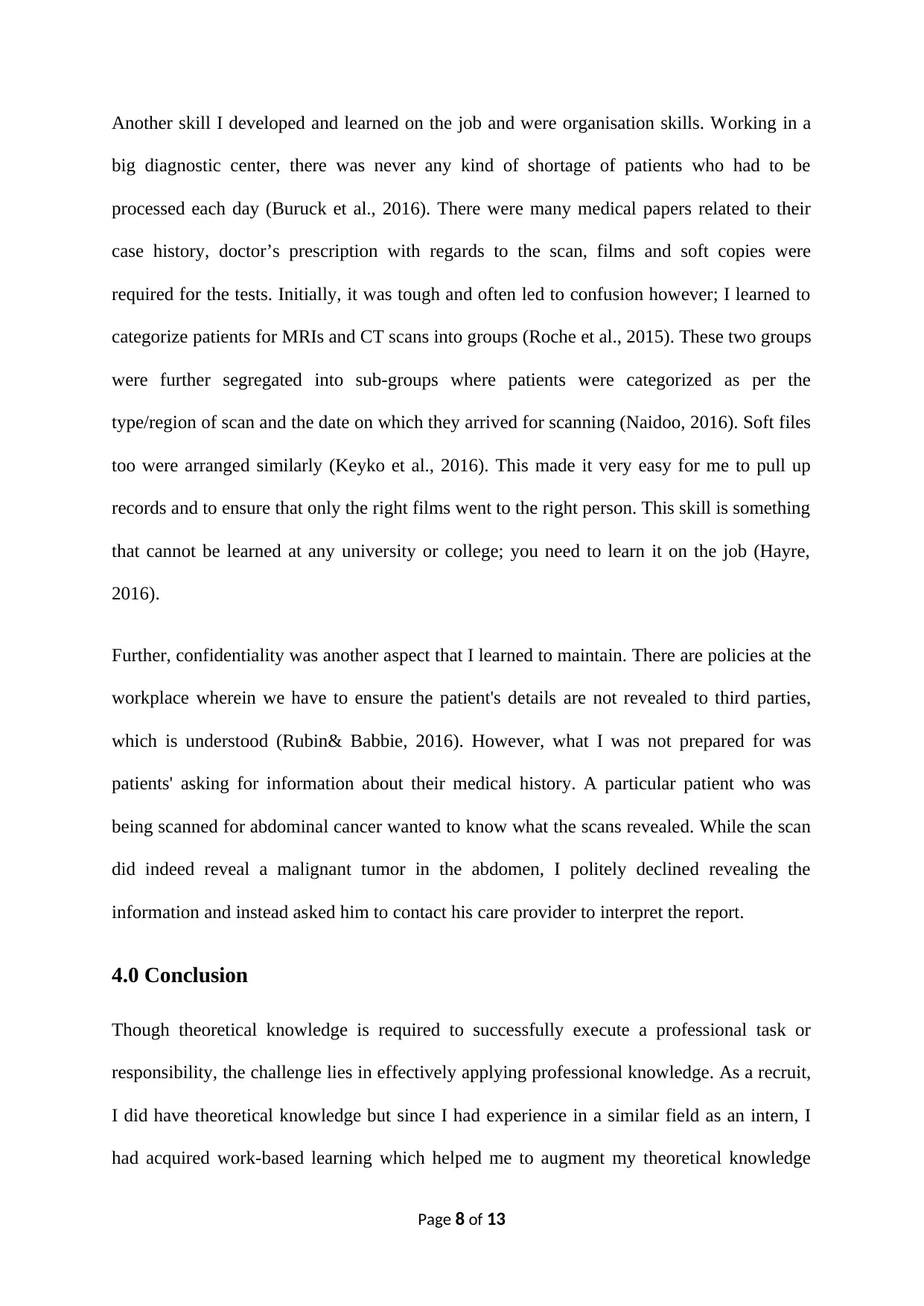
Another skill I developed and learned on the job and were organisation skills. Working in a
big diagnostic center, there was never any kind of shortage of patients who had to be
processed each day (Buruck et al., 2016). There were many medical papers related to their
case history, doctor’s prescription with regards to the scan, films and soft copies were
required for the tests. Initially, it was tough and often led to confusion however; I learned to
categorize patients for MRIs and CT scans into groups (Roche et al., 2015). These two groups
were further segregated into sub-groups where patients were categorized as per the
type/region of scan and the date on which they arrived for scanning (Naidoo, 2016). Soft files
too were arranged similarly (Keyko et al., 2016). This made it very easy for me to pull up
records and to ensure that only the right films went to the right person. This skill is something
that cannot be learned at any university or college; you need to learn it on the job (Hayre,
2016).
Further, confidentiality was another aspect that I learned to maintain. There are policies at the
workplace wherein we have to ensure the patient's details are not revealed to third parties,
which is understood (Rubin& Babbie, 2016). However, what I was not prepared for was
patients' asking for information about their medical history. A particular patient who was
being scanned for abdominal cancer wanted to know what the scans revealed. While the scan
did indeed reveal a malignant tumor in the abdomen, I politely declined revealing the
information and instead asked him to contact his care provider to interpret the report.
4.0 Conclusion
Though theoretical knowledge is required to successfully execute a professional task or
responsibility, the challenge lies in effectively applying professional knowledge. As a recruit,
I did have theoretical knowledge but since I had experience in a similar field as an intern, I
had acquired work-based learning which helped me to augment my theoretical knowledge
Page 8 of 13
big diagnostic center, there was never any kind of shortage of patients who had to be
processed each day (Buruck et al., 2016). There were many medical papers related to their
case history, doctor’s prescription with regards to the scan, films and soft copies were
required for the tests. Initially, it was tough and often led to confusion however; I learned to
categorize patients for MRIs and CT scans into groups (Roche et al., 2015). These two groups
were further segregated into sub-groups where patients were categorized as per the
type/region of scan and the date on which they arrived for scanning (Naidoo, 2016). Soft files
too were arranged similarly (Keyko et al., 2016). This made it very easy for me to pull up
records and to ensure that only the right films went to the right person. This skill is something
that cannot be learned at any university or college; you need to learn it on the job (Hayre,
2016).
Further, confidentiality was another aspect that I learned to maintain. There are policies at the
workplace wherein we have to ensure the patient's details are not revealed to third parties,
which is understood (Rubin& Babbie, 2016). However, what I was not prepared for was
patients' asking for information about their medical history. A particular patient who was
being scanned for abdominal cancer wanted to know what the scans revealed. While the scan
did indeed reveal a malignant tumor in the abdomen, I politely declined revealing the
information and instead asked him to contact his care provider to interpret the report.
4.0 Conclusion
Though theoretical knowledge is required to successfully execute a professional task or
responsibility, the challenge lies in effectively applying professional knowledge. As a recruit,
I did have theoretical knowledge but since I had experience in a similar field as an intern, I
had acquired work-based learning which helped me to augment my theoretical knowledge
Page 8 of 13
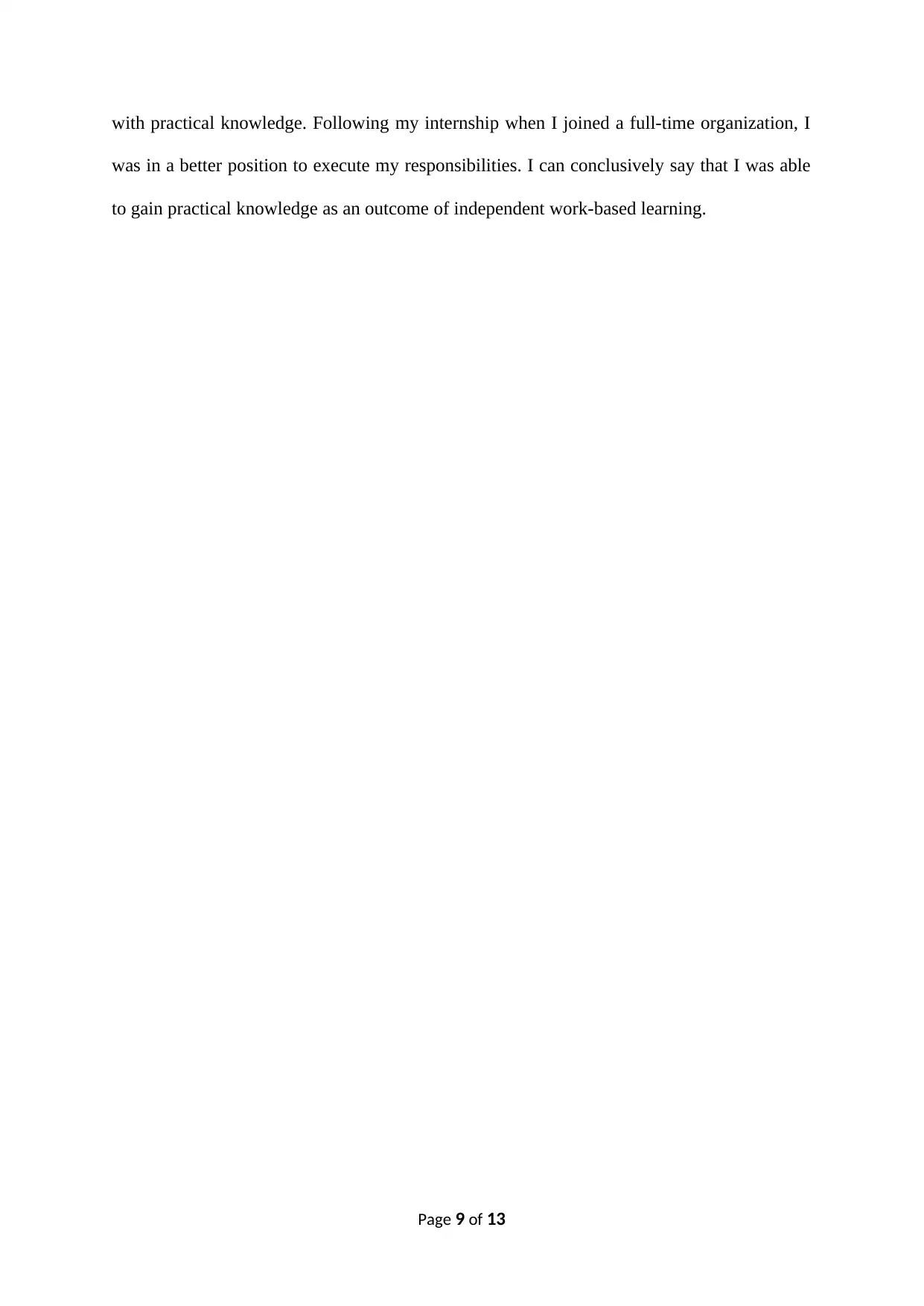
with practical knowledge. Following my internship when I joined a full-time organization, I
was in a better position to execute my responsibilities. I can conclusively say that I was able
to gain practical knowledge as an outcome of independent work-based learning.
Page 9 of 13
was in a better position to execute my responsibilities. I can conclusively say that I was able
to gain practical knowledge as an outcome of independent work-based learning.
Page 9 of 13
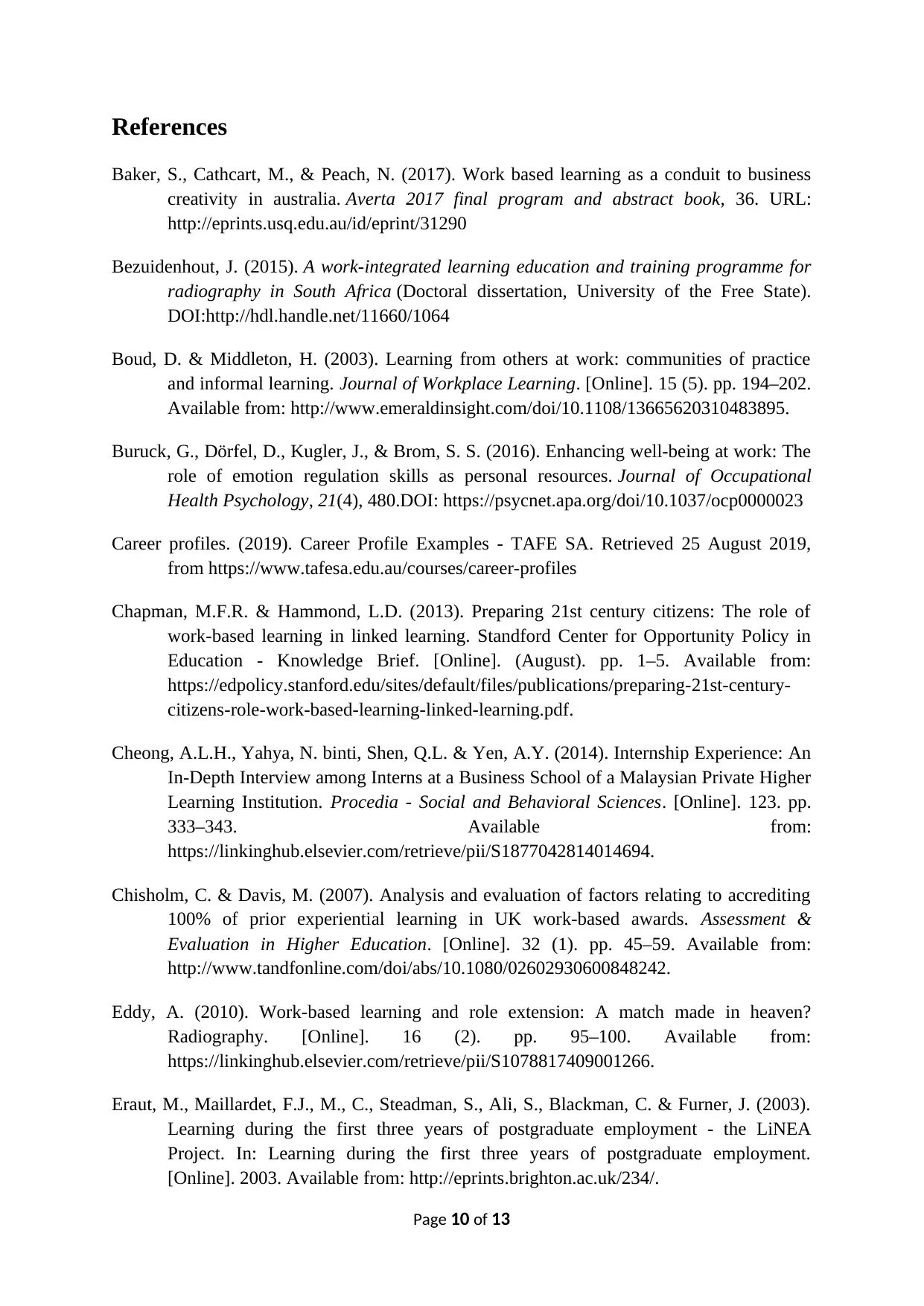
References
Baker, S., Cathcart, M., & Peach, N. (2017). Work based learning as a conduit to business
creativity in australia. Averta 2017 final program and abstract book, 36. URL:
http://eprints.usq.edu.au/id/eprint/31290
Bezuidenhout, J. (2015). A work-integrated learning education and training programme for
radiography in South Africa (Doctoral dissertation, University of the Free State).
DOI:http://hdl.handle.net/11660/1064
Boud, D. & Middleton, H. (2003). Learning from others at work: communities of practice
and informal learning. Journal of Workplace Learning. [Online]. 15 (5). pp. 194–202.
Available from: http://www.emeraldinsight.com/doi/10.1108/13665620310483895.
Buruck, G., Dörfel, D., Kugler, J., & Brom, S. S. (2016). Enhancing well-being at work: The
role of emotion regulation skills as personal resources. Journal of Occupational
Health Psychology, 21(4), 480.DOI: https://psycnet.apa.org/doi/10.1037/ocp0000023
Career profiles. (2019). Career Profile Examples - TAFE SA. Retrieved 25 August 2019,
from https://www.tafesa.edu.au/courses/career-profiles
Chapman, M.F.R. & Hammond, L.D. (2013). Preparing 21st century citizens: The role of
work-based learning in linked learning. Standford Center for Opportunity Policy in
Education - Knowledge Brief. [Online]. (August). pp. 1–5. Available from:
https://edpolicy.stanford.edu/sites/default/files/publications/preparing-21st-century-
citizens-role-work-based-learning-linked-learning.pdf.
Cheong, A.L.H., Yahya, N. binti, Shen, Q.L. & Yen, A.Y. (2014). Internship Experience: An
In-Depth Interview among Interns at a Business School of a Malaysian Private Higher
Learning Institution. Procedia - Social and Behavioral Sciences. [Online]. 123. pp.
333–343. Available from:
https://linkinghub.elsevier.com/retrieve/pii/S1877042814014694.
Chisholm, C. & Davis, M. (2007). Analysis and evaluation of factors relating to accrediting
100% of prior experiential learning in UK work‐based awards. Assessment &
Evaluation in Higher Education. [Online]. 32 (1). pp. 45–59. Available from:
http://www.tandfonline.com/doi/abs/10.1080/02602930600848242.
Eddy, A. (2010). Work-based learning and role extension: A match made in heaven?
Radiography. [Online]. 16 (2). pp. 95–100. Available from:
https://linkinghub.elsevier.com/retrieve/pii/S1078817409001266.
Eraut, M., Maillardet, F.J., M., C., Steadman, S., Ali, S., Blackman, C. & Furner, J. (2003).
Learning during the first three years of postgraduate employment - the LiNEA
Project. In: Learning during the first three years of postgraduate employment.
[Online]. 2003. Available from: http://eprints.brighton.ac.uk/234/.
Page 10 of 13
Baker, S., Cathcart, M., & Peach, N. (2017). Work based learning as a conduit to business
creativity in australia. Averta 2017 final program and abstract book, 36. URL:
http://eprints.usq.edu.au/id/eprint/31290
Bezuidenhout, J. (2015). A work-integrated learning education and training programme for
radiography in South Africa (Doctoral dissertation, University of the Free State).
DOI:http://hdl.handle.net/11660/1064
Boud, D. & Middleton, H. (2003). Learning from others at work: communities of practice
and informal learning. Journal of Workplace Learning. [Online]. 15 (5). pp. 194–202.
Available from: http://www.emeraldinsight.com/doi/10.1108/13665620310483895.
Buruck, G., Dörfel, D., Kugler, J., & Brom, S. S. (2016). Enhancing well-being at work: The
role of emotion regulation skills as personal resources. Journal of Occupational
Health Psychology, 21(4), 480.DOI: https://psycnet.apa.org/doi/10.1037/ocp0000023
Career profiles. (2019). Career Profile Examples - TAFE SA. Retrieved 25 August 2019,
from https://www.tafesa.edu.au/courses/career-profiles
Chapman, M.F.R. & Hammond, L.D. (2013). Preparing 21st century citizens: The role of
work-based learning in linked learning. Standford Center for Opportunity Policy in
Education - Knowledge Brief. [Online]. (August). pp. 1–5. Available from:
https://edpolicy.stanford.edu/sites/default/files/publications/preparing-21st-century-
citizens-role-work-based-learning-linked-learning.pdf.
Cheong, A.L.H., Yahya, N. binti, Shen, Q.L. & Yen, A.Y. (2014). Internship Experience: An
In-Depth Interview among Interns at a Business School of a Malaysian Private Higher
Learning Institution. Procedia - Social and Behavioral Sciences. [Online]. 123. pp.
333–343. Available from:
https://linkinghub.elsevier.com/retrieve/pii/S1877042814014694.
Chisholm, C. & Davis, M. (2007). Analysis and evaluation of factors relating to accrediting
100% of prior experiential learning in UK work‐based awards. Assessment &
Evaluation in Higher Education. [Online]. 32 (1). pp. 45–59. Available from:
http://www.tandfonline.com/doi/abs/10.1080/02602930600848242.
Eddy, A. (2010). Work-based learning and role extension: A match made in heaven?
Radiography. [Online]. 16 (2). pp. 95–100. Available from:
https://linkinghub.elsevier.com/retrieve/pii/S1078817409001266.
Eraut, M., Maillardet, F.J., M., C., Steadman, S., Ali, S., Blackman, C. & Furner, J. (2003).
Learning during the first three years of postgraduate employment - the LiNEA
Project. In: Learning during the first three years of postgraduate employment.
[Online]. 2003. Available from: http://eprints.brighton.ac.uk/234/.
Page 10 of 13
Secure Best Marks with AI Grader
Need help grading? Try our AI Grader for instant feedback on your assignments.
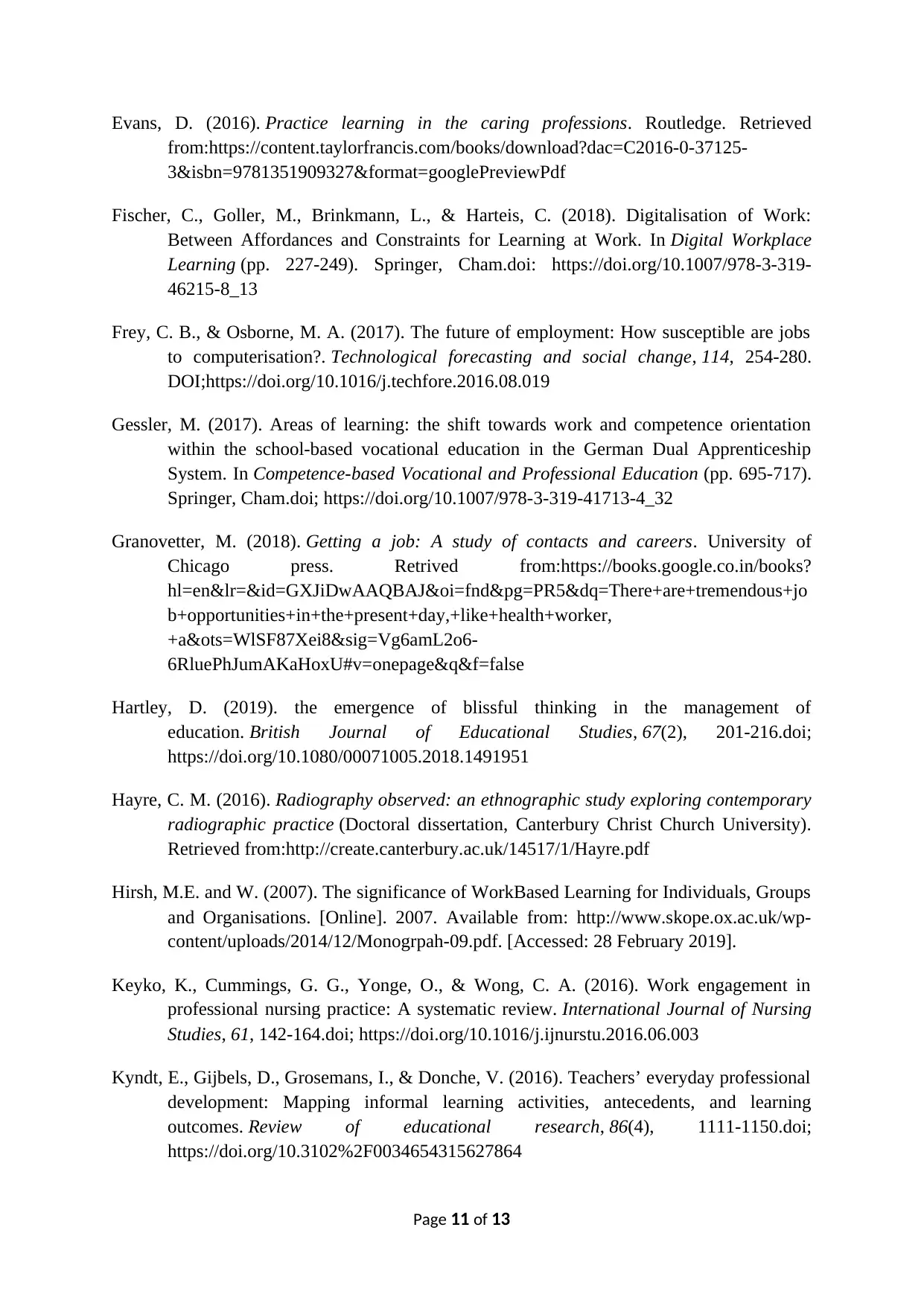
Evans, D. (2016). Practice learning in the caring professions. Routledge. Retrieved
from:https://content.taylorfrancis.com/books/download?dac=C2016-0-37125-
3&isbn=9781351909327&format=googlePreviewPdf
Fischer, C., Goller, M., Brinkmann, L., & Harteis, C. (2018). Digitalisation of Work:
Between Affordances and Constraints for Learning at Work. In Digital Workplace
Learning (pp. 227-249). Springer, Cham.doi: https://doi.org/10.1007/978-3-319-
46215-8_13
Frey, C. B., & Osborne, M. A. (2017). The future of employment: How susceptible are jobs
to computerisation?. Technological forecasting and social change, 114, 254-280.
DOI;https://doi.org/10.1016/j.techfore.2016.08.019
Gessler, M. (2017). Areas of learning: the shift towards work and competence orientation
within the school-based vocational education in the German Dual Apprenticeship
System. In Competence-based Vocational and Professional Education (pp. 695-717).
Springer, Cham.doi; https://doi.org/10.1007/978-3-319-41713-4_32
Granovetter, M. (2018). Getting a job: A study of contacts and careers. University of
Chicago press. Retrived from:https://books.google.co.in/books?
hl=en&lr=&id=GXJiDwAAQBAJ&oi=fnd&pg=PR5&dq=There+are+tremendous+jo
b+opportunities+in+the+present+day,+like+health+worker,
+a&ots=WlSF87Xei8&sig=Vg6amL2o6-
6RluePhJumAKaHoxU#v=onepage&q&f=false
Hartley, D. (2019). the emergence of blissful thinking in the management of
education. British Journal of Educational Studies, 67(2), 201-216.doi;
https://doi.org/10.1080/00071005.2018.1491951
Hayre, C. M. (2016). Radiography observed: an ethnographic study exploring contemporary
radiographic practice (Doctoral dissertation, Canterbury Christ Church University).
Retrieved from:http://create.canterbury.ac.uk/14517/1/Hayre.pdf
Hirsh, M.E. and W. (2007). The significance of WorkBased Learning for Individuals, Groups
and Organisations. [Online]. 2007. Available from: http://www.skope.ox.ac.uk/wp-
content/uploads/2014/12/Monogrpah-09.pdf. [Accessed: 28 February 2019].
Keyko, K., Cummings, G. G., Yonge, O., & Wong, C. A. (2016). Work engagement in
professional nursing practice: A systematic review. International Journal of Nursing
Studies, 61, 142-164.doi; https://doi.org/10.1016/j.ijnurstu.2016.06.003
Kyndt, E., Gijbels, D., Grosemans, I., & Donche, V. (2016). Teachers’ everyday professional
development: Mapping informal learning activities, antecedents, and learning
outcomes. Review of educational research, 86(4), 1111-1150.doi;
https://doi.org/10.3102%2F0034654315627864
Page 11 of 13
from:https://content.taylorfrancis.com/books/download?dac=C2016-0-37125-
3&isbn=9781351909327&format=googlePreviewPdf
Fischer, C., Goller, M., Brinkmann, L., & Harteis, C. (2018). Digitalisation of Work:
Between Affordances and Constraints for Learning at Work. In Digital Workplace
Learning (pp. 227-249). Springer, Cham.doi: https://doi.org/10.1007/978-3-319-
46215-8_13
Frey, C. B., & Osborne, M. A. (2017). The future of employment: How susceptible are jobs
to computerisation?. Technological forecasting and social change, 114, 254-280.
DOI;https://doi.org/10.1016/j.techfore.2016.08.019
Gessler, M. (2017). Areas of learning: the shift towards work and competence orientation
within the school-based vocational education in the German Dual Apprenticeship
System. In Competence-based Vocational and Professional Education (pp. 695-717).
Springer, Cham.doi; https://doi.org/10.1007/978-3-319-41713-4_32
Granovetter, M. (2018). Getting a job: A study of contacts and careers. University of
Chicago press. Retrived from:https://books.google.co.in/books?
hl=en&lr=&id=GXJiDwAAQBAJ&oi=fnd&pg=PR5&dq=There+are+tremendous+jo
b+opportunities+in+the+present+day,+like+health+worker,
+a&ots=WlSF87Xei8&sig=Vg6amL2o6-
6RluePhJumAKaHoxU#v=onepage&q&f=false
Hartley, D. (2019). the emergence of blissful thinking in the management of
education. British Journal of Educational Studies, 67(2), 201-216.doi;
https://doi.org/10.1080/00071005.2018.1491951
Hayre, C. M. (2016). Radiography observed: an ethnographic study exploring contemporary
radiographic practice (Doctoral dissertation, Canterbury Christ Church University).
Retrieved from:http://create.canterbury.ac.uk/14517/1/Hayre.pdf
Hirsh, M.E. and W. (2007). The significance of WorkBased Learning for Individuals, Groups
and Organisations. [Online]. 2007. Available from: http://www.skope.ox.ac.uk/wp-
content/uploads/2014/12/Monogrpah-09.pdf. [Accessed: 28 February 2019].
Keyko, K., Cummings, G. G., Yonge, O., & Wong, C. A. (2016). Work engagement in
professional nursing practice: A systematic review. International Journal of Nursing
Studies, 61, 142-164.doi; https://doi.org/10.1016/j.ijnurstu.2016.06.003
Kyndt, E., Gijbels, D., Grosemans, I., & Donche, V. (2016). Teachers’ everyday professional
development: Mapping informal learning activities, antecedents, and learning
outcomes. Review of educational research, 86(4), 1111-1150.doi;
https://doi.org/10.3102%2F0034654315627864
Page 11 of 13
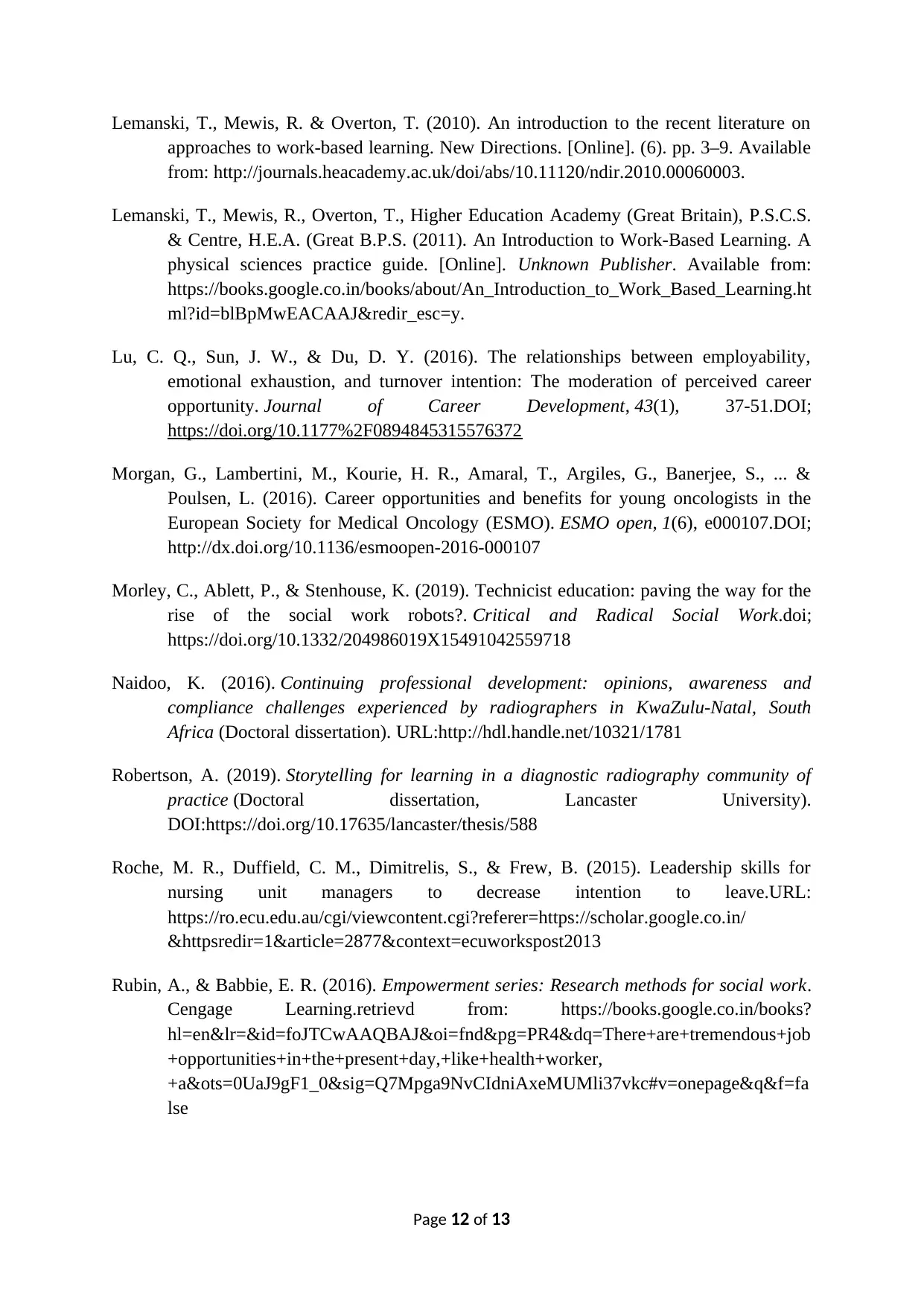
Lemanski, T., Mewis, R. & Overton, T. (2010). An introduction to the recent literature on
approaches to work-based learning. New Directions. [Online]. (6). pp. 3–9. Available
from: http://journals.heacademy.ac.uk/doi/abs/10.11120/ndir.2010.00060003.
Lemanski, T., Mewis, R., Overton, T., Higher Education Academy (Great Britain), P.S.C.S.
& Centre, H.E.A. (Great B.P.S. (2011). An Introduction to Work-Based Learning. A
physical sciences practice guide. [Online]. Unknown Publisher. Available from:
https://books.google.co.in/books/about/An_Introduction_to_Work_Based_Learning.ht
ml?id=blBpMwEACAAJ&redir_esc=y.
Lu, C. Q., Sun, J. W., & Du, D. Y. (2016). The relationships between employability,
emotional exhaustion, and turnover intention: The moderation of perceived career
opportunity. Journal of Career Development, 43(1), 37-51.DOI;
https://doi.org/10.1177%2F0894845315576372
Morgan, G., Lambertini, M., Kourie, H. R., Amaral, T., Argiles, G., Banerjee, S., ... &
Poulsen, L. (2016). Career opportunities and benefits for young oncologists in the
European Society for Medical Oncology (ESMO). ESMO open, 1(6), e000107.DOI;
http://dx.doi.org/10.1136/esmoopen-2016-000107
Morley, C., Ablett, P., & Stenhouse, K. (2019). Technicist education: paving the way for the
rise of the social work robots?. Critical and Radical Social Work.doi;
https://doi.org/10.1332/204986019X15491042559718
Naidoo, K. (2016). Continuing professional development: opinions, awareness and
compliance challenges experienced by radiographers in KwaZulu-Natal, South
Africa (Doctoral dissertation). URL:http://hdl.handle.net/10321/1781
Robertson, A. (2019). Storytelling for learning in a diagnostic radiography community of
practice (Doctoral dissertation, Lancaster University).
DOI:https://doi.org/10.17635/lancaster/thesis/588
Roche, M. R., Duffield, C. M., Dimitrelis, S., & Frew, B. (2015). Leadership skills for
nursing unit managers to decrease intention to leave.URL:
https://ro.ecu.edu.au/cgi/viewcontent.cgi?referer=https://scholar.google.co.in/
&httpsredir=1&article=2877&context=ecuworkspost2013
Rubin, A., & Babbie, E. R. (2016). Empowerment series: Research methods for social work.
Cengage Learning.retrievd from: https://books.google.co.in/books?
hl=en&lr=&id=foJTCwAAQBAJ&oi=fnd&pg=PR4&dq=There+are+tremendous+job
+opportunities+in+the+present+day,+like+health+worker,
+a&ots=0UaJ9gF1_0&sig=Q7Mpga9NvCIdniAxeMUMli37vkc#v=onepage&q&f=fa
lse
Page 12 of 13
approaches to work-based learning. New Directions. [Online]. (6). pp. 3–9. Available
from: http://journals.heacademy.ac.uk/doi/abs/10.11120/ndir.2010.00060003.
Lemanski, T., Mewis, R., Overton, T., Higher Education Academy (Great Britain), P.S.C.S.
& Centre, H.E.A. (Great B.P.S. (2011). An Introduction to Work-Based Learning. A
physical sciences practice guide. [Online]. Unknown Publisher. Available from:
https://books.google.co.in/books/about/An_Introduction_to_Work_Based_Learning.ht
ml?id=blBpMwEACAAJ&redir_esc=y.
Lu, C. Q., Sun, J. W., & Du, D. Y. (2016). The relationships between employability,
emotional exhaustion, and turnover intention: The moderation of perceived career
opportunity. Journal of Career Development, 43(1), 37-51.DOI;
https://doi.org/10.1177%2F0894845315576372
Morgan, G., Lambertini, M., Kourie, H. R., Amaral, T., Argiles, G., Banerjee, S., ... &
Poulsen, L. (2016). Career opportunities and benefits for young oncologists in the
European Society for Medical Oncology (ESMO). ESMO open, 1(6), e000107.DOI;
http://dx.doi.org/10.1136/esmoopen-2016-000107
Morley, C., Ablett, P., & Stenhouse, K. (2019). Technicist education: paving the way for the
rise of the social work robots?. Critical and Radical Social Work.doi;
https://doi.org/10.1332/204986019X15491042559718
Naidoo, K. (2016). Continuing professional development: opinions, awareness and
compliance challenges experienced by radiographers in KwaZulu-Natal, South
Africa (Doctoral dissertation). URL:http://hdl.handle.net/10321/1781
Robertson, A. (2019). Storytelling for learning in a diagnostic radiography community of
practice (Doctoral dissertation, Lancaster University).
DOI:https://doi.org/10.17635/lancaster/thesis/588
Roche, M. R., Duffield, C. M., Dimitrelis, S., & Frew, B. (2015). Leadership skills for
nursing unit managers to decrease intention to leave.URL:
https://ro.ecu.edu.au/cgi/viewcontent.cgi?referer=https://scholar.google.co.in/
&httpsredir=1&article=2877&context=ecuworkspost2013
Rubin, A., & Babbie, E. R. (2016). Empowerment series: Research methods for social work.
Cengage Learning.retrievd from: https://books.google.co.in/books?
hl=en&lr=&id=foJTCwAAQBAJ&oi=fnd&pg=PR4&dq=There+are+tremendous+job
+opportunities+in+the+present+day,+like+health+worker,
+a&ots=0UaJ9gF1_0&sig=Q7Mpga9NvCIdniAxeMUMli37vkc#v=onepage&q&f=fa
lse
Page 12 of 13
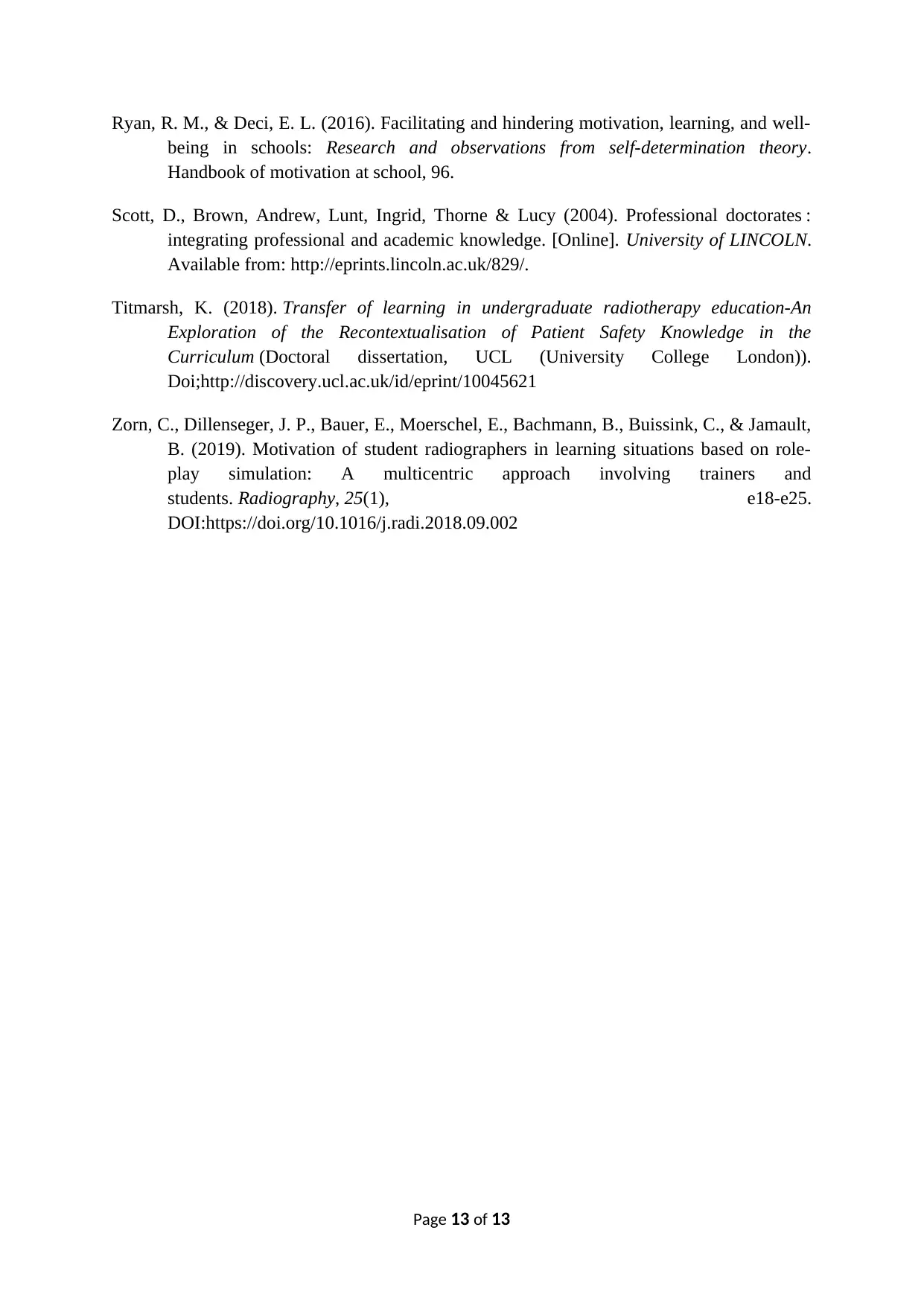
Ryan, R. M., & Deci, E. L. (2016). Facilitating and hindering motivation, learning, and well-
being in schools: Research and observations from self-determination theory.
Handbook of motivation at school, 96.
Scott, D., Brown, Andrew, Lunt, Ingrid, Thorne & Lucy (2004). Professional doctorates :
integrating professional and academic knowledge. [Online]. University of LINCOLN.
Available from: http://eprints.lincoln.ac.uk/829/.
Titmarsh, K. (2018). Transfer of learning in undergraduate radiotherapy education-An
Exploration of the Recontextualisation of Patient Safety Knowledge in the
Curriculum (Doctoral dissertation, UCL (University College London)).
Doi;http://discovery.ucl.ac.uk/id/eprint/10045621
Zorn, C., Dillenseger, J. P., Bauer, E., Moerschel, E., Bachmann, B., Buissink, C., & Jamault,
B. (2019). Motivation of student radiographers in learning situations based on role-
play simulation: A multicentric approach involving trainers and
students. Radiography, 25(1), e18-e25.
DOI:https://doi.org/10.1016/j.radi.2018.09.002
Page 13 of 13
being in schools: Research and observations from self-determination theory.
Handbook of motivation at school, 96.
Scott, D., Brown, Andrew, Lunt, Ingrid, Thorne & Lucy (2004). Professional doctorates :
integrating professional and academic knowledge. [Online]. University of LINCOLN.
Available from: http://eprints.lincoln.ac.uk/829/.
Titmarsh, K. (2018). Transfer of learning in undergraduate radiotherapy education-An
Exploration of the Recontextualisation of Patient Safety Knowledge in the
Curriculum (Doctoral dissertation, UCL (University College London)).
Doi;http://discovery.ucl.ac.uk/id/eprint/10045621
Zorn, C., Dillenseger, J. P., Bauer, E., Moerschel, E., Bachmann, B., Buissink, C., & Jamault,
B. (2019). Motivation of student radiographers in learning situations based on role-
play simulation: A multicentric approach involving trainers and
students. Radiography, 25(1), e18-e25.
DOI:https://doi.org/10.1016/j.radi.2018.09.002
Page 13 of 13
1 out of 13
Related Documents
Your All-in-One AI-Powered Toolkit for Academic Success.
+13062052269
info@desklib.com
Available 24*7 on WhatsApp / Email
![[object Object]](/_next/static/media/star-bottom.7253800d.svg)
Unlock your academic potential
© 2024 | Zucol Services PVT LTD | All rights reserved.


